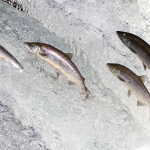Brazil is a giant in Latin America: it boasts a population of more than 213 million people and a GDP of some USD 1.45 trillion (EUR 1.33 trillion), according to World Bank data. Currently it exports only about USD 365 million (EUR 334 million) in seafood, but the Brazilian Trade and Investment Promotion Agency, Apex-Brasil, is looking to change that.
Compared to some other South American nations, Brazil definitely has room to grow its seafood exports. Chile, with a population of 19 million people and a GDP of USD 253 billion (EUR 231 billion); and Ecuador, with a population 18 million and a GDP of USD 98.8 billion (EUR 90.3 billion); last year exported more than USD 5 billion (EUR 4.6 billion) in salmon and shrimp, respectively.
How does Brazil plan to catch up? There are lessons to be learned from the country’s poultry sector, Alberto Carlos Bicca, Agribusiness Coordinator at Apex-Brasil, told SeafoodSource. Brazil is the world’s largest exporter of chicken meat, forecast to export 4.17 million tons this year, a 3 percent increase, after having risen 5 percent in 2021, according to data from the U.S. Department of Agriculture.
“The focus on seafood until now has been the internal consumption, the domestic market, and companies haven’t bothered to look outside. But we have some big companies and cooperatives that are getting involved, such as [agro-industrial cooperative] Copacol, which is very strong in poultry production and exports, and now they’re using a similar system for tilapia,” he said. “They’re starting to produce more and have made a great investment to do that, also grouping together many fish farmers. They have big plans to produce and process fish … Brazil exports USD 8 billion [EUR 7.3 billion] in poultry a year, so it wouldn’t be difficult to reach USD 1.5 billion [EUR 1.4 billion] in tilapia and other seafood exports in five to eight years to North America.”
The U.S. market is by far Brazil’s top destination for its current seafood exports. Since 2016, Brazilian seafood sales to the U.S. have grown approximately 17.2 percent a year in value and 13.9 percent in volume. Last year alone, the country exported 59.5 percent of its total seafood exports to the United States, for a total value of some USD 219 million (EUR 200 million). Its main products included lobster, with USD 72.6 million (EUR 66.4 million) sent to the U.S.; miscellaneous fish including tuna, snapper, sardines, and tilapia worth USD 44.7 million (EUR 40.9 million); and frozen snapper, of which USD 36.3 million (EUR 33.2 million) was imported by the United States, Apex Brasil reported. Brazilian tilapia is particularly growing in popularity in the U.S. market, with 64 percent of total Brazilian exports of the fish bound for that market.
Brazilian companies are participating in trade shows to foster further growth. Together with the Brazilian Fishing Industry Association (ABIPESCA) and the Brazilian Fish Farming Association (PeixeBR), Apex Brasil will help bring 11 Brazilian companies to spotlight their seafood products at Seafood Expo North America, ongoing through 15 March, 2022, in Boston, Massachusetts, U.S.A. Brazilian companies participating at SENA include:
- Profand Group/Produmar (specializing in frozen seafood, including mahi, giant squid, octopus, and hake)
- Copacol (tilapia, hake, tambaqui)
- Allmare Alimentos (lobster, shrimp, and a variety of fish)
- Bello Alimentos which owns Mar & Terra, a brand specializing in the production of Amazonian fish such as pintado, pacu, pirarucu, tambaqui, and tilapia
- Cais do Atlântico (bluefish, hake, yellowfin tuna, skipjack tuna, rocker, and mackerel)
- JC Alimentos/JC Pescados (tuna, lobster, shrimp, and other sea fish)
- Independent Brazil (seafood import/export, as well as fish skin and scales)
- Central de Pescados Mourão, committed to the effective deliverability and traceability of its fish products
- Blaze (croaker, mahi, monkfish, mullet, octopus, roe, prawns, and scampi)
- MCassab Group/Fider Pescados (fresh and frozen tilapia)
- Zaltana Pescados (Amazonian fish such as tambaqui, pintado, pirarucu, and tambatinga)
The message these Seafood Expo North America participants are looking to share is that Brazil can offer great quality as a supplier, with lots of raw materials to use in production, such as corn and soybeans, Bicca said.
“We can’t compete in frozen fish with China or Vietnam, and so we’re making a strategic effort to support bigger, fresh, high-quality fillets,” he added.
Another area that Brazil may be able to make a significant splash is in shrimp exports, Bicca said.
“Brazil was a great exporter of shrimp to the U.S. about 10 to 15 years ago, when we had export levels similar to Ecuador. But we had some commercial issues and then we were hit with white spot syndrome. Now we’re coming back and some companies can produce a lot of shrimp,” he said.
Apex-Brasil is part of the Brazilian Ministry of Foreign Affairs (Itamaraty), which has more than 120 offices around the world. The agency’s service portfolio ranges from preparing market data intelligence to connecting investors to high-level authorities offering solutions for industries including agribusiness, automotive, aerospace, real estate, renewable energy, health and life sciences, infrastructure, oil and gas, and private equity and venture capital. To date, it has served over 1300 investors in 118 projects worth USD 23 billion (EUR 21 billion) in Brazil.
Photo by Abigael Sleeper/SeafoodSource







